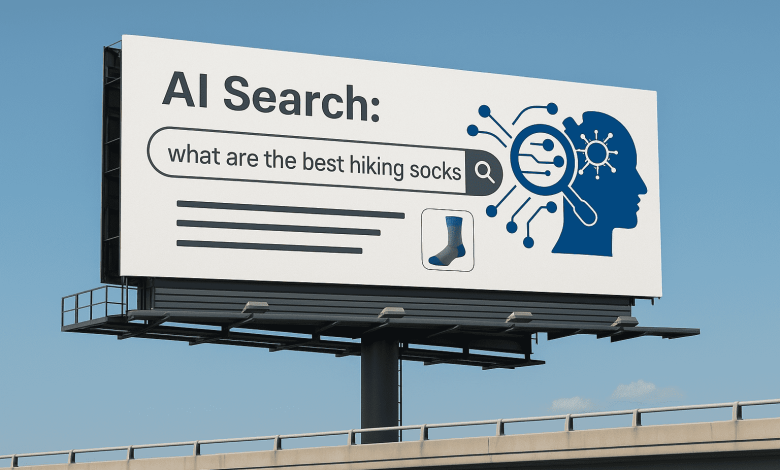
The New Front Door to the Internet
For more than two decades, the way people discover products and services online has revolved around search engines. Ranking on Google’s first page was once the holy grail of visibility, while digital advertising platforms promised brands the chance to intercept customers with targeted messages. That entire landscape is shifting beneath our feet. The rise of generative AI search through tools such as ChatGPT, Google’s AI Overviews, Perplexity, and Gemini, has created a new front door to the internet.
These systems aren’t just giving people links to click. They are summarizing information, making recommendations, and in some cases even completing purchases. For brands, the implications are enormous: being visible in AI search is becoming the new billboard of the digital economy.
Changing Consumer Behavior
The shift is already measurable in user behavior. Surveys show that more than half of U.S. consumers now prefer to use generative AI tools for tasks they once handled with Google, whether that’s planning travel, comparing tech products, or finding gift ideas. Younger demographics, especially Gen Z, are even more likely to start with AI.
At the same time, news and media publishers are sounding the alarm. With Google’s AI Overviews displaying answers directly in search results, many outlets are reporting drops of 80 to 90 percent in referral traffic. It is not hard to see why… if the answer is right there, neatly summarized by AI, the incentive to click through dwindles. What this means for brands is stark: if you are not cited or represented in the summary itself, you may never be seen.
Recognition Over Ranking
This makes the battleground less about ranking and more about recognition. In traditional search, showing up in the top three links was enough. In AI search, the goal is to be the answer, not just an option.
Data from Semrush illustrates the stakes. Visitors referred through AI-driven summaries are worth more than four times as much as traditional organic search visitors, largely because by the time they arrive, they are already primed with information that validates your brand. The visibility challenge is compounded by scale… more than 70 percent of U.S. consumers are already using AI search tools regularly. Visibility there is not a nice-to-have; it is the new competitive edge.
Why You Can’t Buy Your Way In
The interesting twist is that visibility in AI is not something you can buy in the way you purchase search ads. These platforms are not selling placements inside their generated answers. Instead, the algorithms rely on patterns of credibility, citation, and authority.
Research from Ahrefs highlights that brand mentions, branded searches, and links associated with authority carry far more weight in determining whether an AI system includes you in its response than any level of ad spending. Brands with higher volumes of mentions on the open web are seeing as much as ten times more representation in AI summaries compared to competitors with fewer references. The implication is clear: you cannot simply pay your way into visibility in this new ecosystem. You must earn it (note that this could always change if the LLM providers change their stance on advertising, but for now that is not possible).
Earning Visibility Through Structure and Clarity
Earning visibility in AI search requires a different kind of discipline than optimizing for keywords. The models ingest structured information, weigh freshness, and synthesize context. Schema markup, for example, has become an underappreciated factor in how AI systems interpret and present information, with companies like Microsoft acknowledging its role in improving accuracy.
Content that is recent, structured, and aligned with user intent is far more likely to surface. This is a departure from the days when search optimization meant repeating keywords in a headline. Today, if a consumer asks “what’s the best waterproof hiking sock for wet trails,” the AI is looking for nuanced, comparison-ready content, not generic descriptions. The brands that invest in clarity and utility are the ones showing up in answers.
The infrastructure underneath all this matters as well. AI models cannot cite what they cannot crawl, and technical setup plays a role. Crawlability through files like robots.txt or llms.txt, clean metadata, and accessible structured data are no longer optional. They form the plumbing that makes your brand discoverable in the first place.
On top of that, the freshness of content is a critical signal. Retrieval-augmented generation, the mechanism many AI systems use to pull live information, favors sources that update often and provide timely details. Brands that publish static content and leave it untouched are likely to be overlooked.
AI as a Commerce Layer
All of this intersects with an even bigger trend: AI is moving from a search tool to a commerce layer. Already, early prototypes of AI systems that handle payments and checkout inside the chatbot environment are being tested. Analysts have noted that “commerce without clicks” is on the horizon, where the decision and the transaction both happen inside an AI interface.
If that model takes off, the power dynamics shift entirely. Instead of websites being the endpoint of discovery, they become one of many inputs feeding AI engines that intermediate the purchase itself. For brands, this means that discoverability is moving upstream into the models, and failing to optimize for it could leave you cut out of the transaction entirely.
In retail, the rise of AI shopping agents is the clearest example. These autonomous systems can browse multiple retailers, compare prices, evaluate reviews, and even complete purchases on behalf of the consumer. The Financial Times has reported that some agents are already operating at this level, meaning that customers may never interact with your website at all. In such a world, visibility in AI search is not just about marketing presence, it becomes the determinant of whether your brand is even in the running. Product data that is incomplete, messy, or unstructured risks exclusion.
Large brands are not leaving this to chance. Companies from Nike to LVMH are already creating executive roles dedicated to AI oversight, including Chief AI Officers tasked with ensuring strategy, governance, and visibility alignment across their organizations. This is an acknowledgment that being seen in AI search is now a boardroom-level issue. Smaller companies may not need a dedicated executive, but they do need someone accountable for shaping how the brand shows up when AI engines are asked the questions that matter.
Strategies Businesses Can Use
For businesses of any size, the most important thing to recognize is that AI visibility can be improved with the right strategies. Brands can start by auditing how they appear across generative tools today. Typing your own brand and category into ChatGPT, Perplexity, or Google’s AI Overviews can provide an unfiltered look at whether you are in the conversation or absent from it.
Beyond that, investing in earned mentions through press coverage, expert commentary, and thought leadership helps ensure there are credible references for AI systems to cite. Structuring content with schema markup and clear, answer-oriented copy makes it easier for models to extract accurate insights. Publishing regularly and with intent ensures freshness, while cross-team coordination between marketing, product, and communications keeps the messaging consistent. These are not quick hacks but disciplines that pay dividends over time.
The Clock Is Ticking
The urgency is underscored by projections of just how fast AI search could displace traditional search. Semrush predicts that within two to four years, AI referrals could surpass organic search traffic altogether. At the same time, the global AI-driven marketing industry is exploding, already valued at more than $47 billion in 2025 and forecast to grow at a compounded rate of over 36 percent annually toward the end of the decade. These numbers paint a clear picture: brands that treat AI visibility as optional are setting themselves up for obscurity.
The new digital billboard, then, is not a screen on a highway or even an ad slot on a webpage. It is the moment when an AI assistant, asked by a consumer, decides which brands to name. The scale of exposure is potentially larger than anything traditional advertising could buy.
Unlike a billboard, though, you cannot rent the space. You must prove your worthiness through trust, credibility, structure, and presence. If your brand becomes the trusted answer, the AI will display you repeatedly, across contexts, to an audience that is already searching with intent.
What makes this moment unique is that AI doesn’t reward noise. It doesn’t care who shouts the loudest or spends the most. It rewards clarity, authority, and usefulness.
For brands that have invested in genuine value, there has rarely been a more promising time to be seen. For those relying on shallow tactics, the risk of disappearing has never been higher. The billboard of the future is not glowing in neon. It is glowing in a chat window, and it will either feature you or it won’t. The choice of whether you are present when that happens depends on how you act now.




